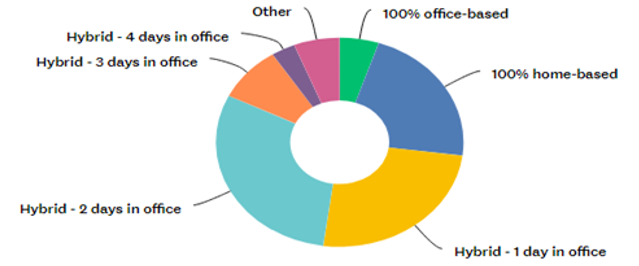Up until three years ago remote-working contracts were far less common, it was far more typical to have a 100% office-based role. Roll the clock forward three years and it has become a firmly established, and expected practice sought by many workers who have seen the benefits a remote-based or hybrid working contract has provided. In many instances these benefits are equally recognised by employers.
Our Sammons Pensions Annual Salary survey, 2022, findings:

Typical working pattern
This was the first time we have reported on this data
Hybrid – 2 days in office was most common, for over 30% of respondents, 1 day in office for 23% of respondents and 100% home-based for 22% respondents.
Comments included being able to work remotely whilst spending times across various hubs or at client meetings around the UK; having the option to be fully flexible with some office days strongly encouraged; attending the office subject to business needs such as key meetings; having varied working patterns across the team from <1 day per week to 100% office-based; enforced by employer, not based on operational needs; contractually office-based but only required to attend meetings: occasional days in office, around once a fortnight; contractually three days a week but prefer four days office-based to have interaction with colleagues; prefer to work in the office but am able to work from home for up to 3 days per week covering train strikes or when needed for other short notice reasons.
Financial-world reported online searches for ‘work from home jobs’ have hit their highest point in five years, spiking by 123% January 2023, whilst ‘hybrid roles’ searches also at a five year high in the UK, exploding by 614% January 2023.
Relevant and regular, open and transparent communications:
Remote or hybrid working doesn’t come without its challenges, and building trust is a key component and not necessarily the easiest to find the right balance between ensuring someone is delivering as expected versus that person feeling they are being policed. This can be particularly difficult if an individual appears to be underperforming, do they need more support/in a different way, are they not interested in contributing fully, are there other issues they are facing?
What is best practice in terms of monitoring remote workers? Birgit Schyns, Distinguished Professor of People and Organisations at NEOMA Business School, co-authored a study analysing employees at UK-based firms, reporting “day-to-day monitoring leaves remote workers wondering why their managers are making such frequent demands, which may leave them questioning their own ability and putting themselves down. At the end of the day, some employees feel physically and intellectually exhausted”.
According to the research, when working from home, employees can feel that they have less autonomy and are under constant surveillance if monitored too frequently. This could be anything from ‘Checking in’ on Teams if a manager notices that the employee has been ‘away’ for a while, to making a call just to ‘see how they are’. These feelings can be exacerbated if managers’ behaviour is unpredictable.
The key is balance, it’s not about an employee doing all the hard work to earn trust, nor is it about managers stepping back and being 100% absent from workers’ lives with a view to being seen as ‘trusting’. Micromanaging can affect morale and actually negatively impact productivity, so managers need to find a way to give their employees the space to get their work done in a positive and empowering way. Employees and their line managers need to agree clear expectations and provide regular feedback. Managers should be encouraged to ask for specific training from HR to help create a culture of trust and autonomy for remote teams, as this may not have been a skillset they’ve previously developed.